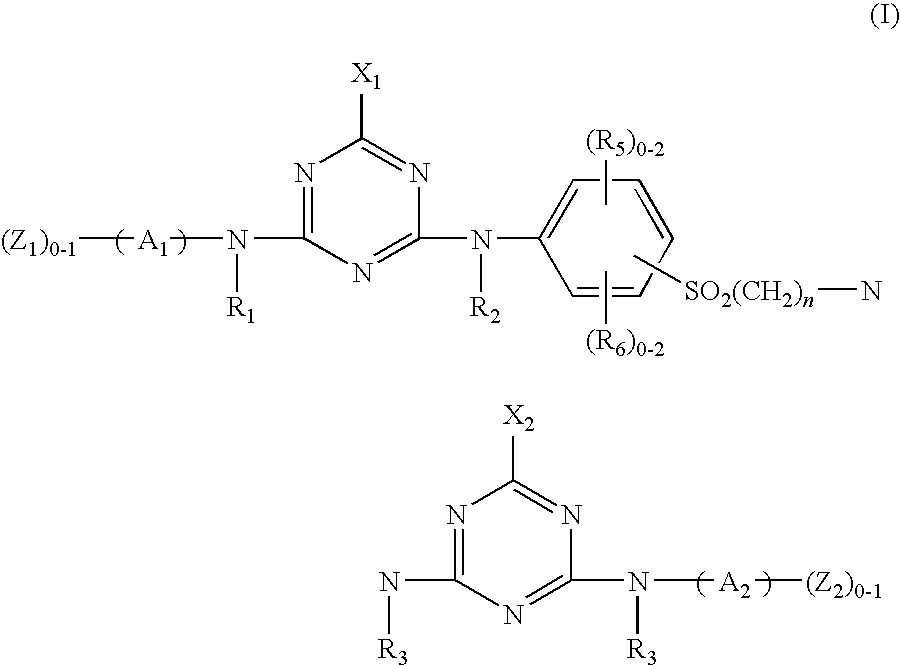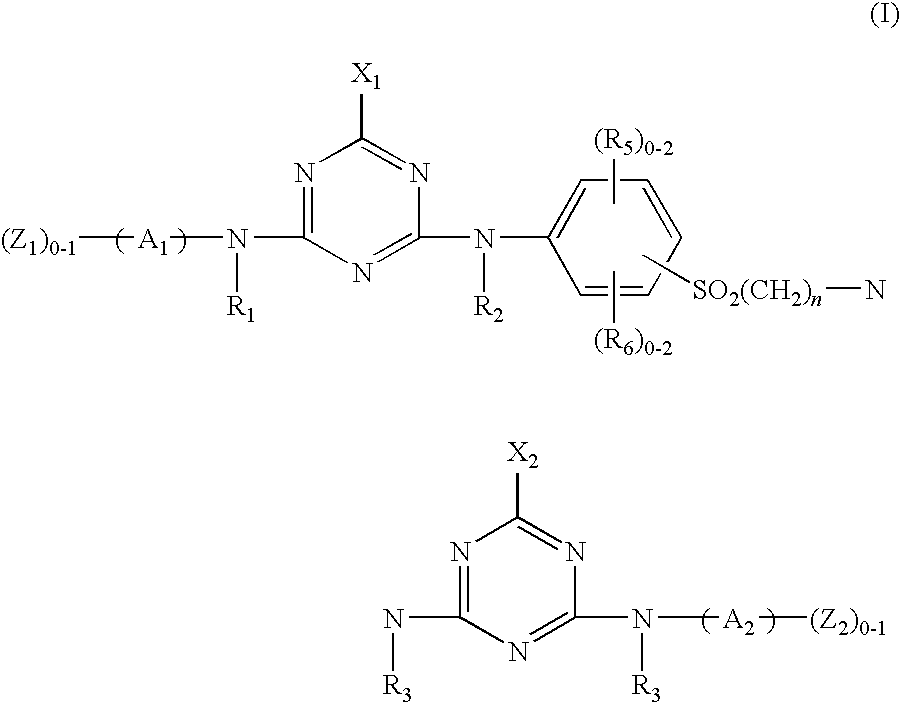Novel reactive dyestuff with N-alkylamino group
a technology of reactive dyestuffs and n-alkylamino groups, which is applied in the direction of organic dyes, indigoid dyes, chemistry apparatus and processes, etc., can solve the problems that the levelness and wash fastness of the aforementioned novel dyestuffs cannot meet the market requirements, the dyed materials exhibit poor water fastness, and the dyed materials have poor wash fastness, so as to improve the fixation yield and wash fastness. high
- Summary
- Abstract
- Description
- Claims
- Application Information
AI Technical Summary
Benefits of technology
Problems solved by technology
Method used
Image
Examples
example 1
[0056](a) 18.8 parts of cyanuric chloride are dispersed in 200 parts of 0° C. water, followed by the addition of a solution containing 31.9 parts of 4-amino-5-hydroxy-2,7-naphthalenedisulfonic acid. Next, the pH value of the reaction solution is adjusted to a range of 1 to 3 by the addition of 15% Na2CO3 (aq), and its temperature is maintained below 5° C. to perform reaction for 2 hours. Finally, the reaction solution is filtered and the filtrate is reserved.
[0057](b) 28.1 parts of 4-(β-sulfatoethylsulfone) aniline and 25.6 parts of 32% HCl (aq) are added into 300 parts of 0° C. water with thorough stirring to form a dispersion solution, followed by the addition of 7.2 parts of sodium nitrite. The temperature of the solution is controlled in a range of 0° C. to 5° C. until the diazotization is accomplished. Subsequently, the above filtrate prepared in the step (a) is added therein, and the pH value of the reaction solution is adjusted to a range of 6 to 8 by the addition of Na2CO3. ...
example 2
[0059](a) 18.8 parts of cyanuric chloride are dispersed in 200 parts of 0° C. water, followed by the addition of 18.8 parts of 2,4-diaminobenzene-1-sulfonic acid powder. Next, the pH value of the reaction solution is adjusted to a range of 1 to 3 by the addition of 15% Na2CO3 (aq), and its temperature is maintained below 5° C. to perform reaction for 2 hours.
[0060](b) 36.1 parts of 1-aminobenzene-4-(b-sulfatoethyl sulfone)-2-sulfonic acid and 30 parts of 32% HCl (aq) are added into 150 parts of 0° C. water with thorough stirring, followed by the addition of 7.2 parts of sodium nitrite. The reaction solution is stirred until the diazotization is accomplished. Subsequently, the above solution prepared in the step (a) is added therein, and the pH value of the reaction solution is adjusted to a range of 6 to 7 by the addition of Na2CO3. The reaction is performed for 3 hours to obtain an orange product.
[0061](c) To the above aqueous solution prepared in the step (b), 12.2 parts of 2-meth...
example 3
[0062](a) 18.8 parts of cyanuric chloride are dispersed in 200 parts of 0° C. water, followed by the addition of a solution containing 31.9 parts of 4-amino-5-hydroxy-2,7-naphthalenedisulfonic acid. Next, the pH value of the reaction solution is adjusted to a range of 1 to 3 by the addition of 15% Na2CO3 (aq), and its temperature is maintained below 5° C. to perform reaction for 2 hours. Finally, the reaction solution is filtered and the filtrate is reserved.
[0063](b) 28.1 parts of 4-(β-sulfatoethylsulfone) aniline and 25.6 parts of 32% HCl (aq) are added into 300 parts of 0° C. water with thorough stirring to form a dispersion solution, followed by the addition of 7.2 parts of sodium nitrite. The temperature of the solution is controlled in a range of 0° C. to 5° C. until the diazotization is accomplished. Subsequently, the above filtrate prepared in the step (a) is added therein, and the pH value of the reaction solution is adjusted to a range of 6 to 8 by the addition of Na2CO3. ...
PUM
| Property | Measurement | Unit |
|---|---|---|
| temperature | aaaaa | aaaaa |
| temperature | aaaaa | aaaaa |
| temperature | aaaaa | aaaaa |
Abstract
Description
Claims
Application Information
 Login to View More
Login to View More - R&D
- Intellectual Property
- Life Sciences
- Materials
- Tech Scout
- Unparalleled Data Quality
- Higher Quality Content
- 60% Fewer Hallucinations
Browse by: Latest US Patents, China's latest patents, Technical Efficacy Thesaurus, Application Domain, Technology Topic, Popular Technical Reports.
© 2025 PatSnap. All rights reserved.Legal|Privacy policy|Modern Slavery Act Transparency Statement|Sitemap|About US| Contact US: help@patsnap.com



